Mexico
Fascinating Heritage and Cultural Treasures
Mexico is a land of vibrant cultural heritage and a tapestry woven from diverse indigenous roots. Beyond the renowned Aztec civilization, Mexico boasts a rich and varied indigenous legacy that continues to shape its identity. From the ancient Maya civilization to the Zapotec, Mixtec, Tarahumara, Otomi, and numerous other indigenous groups, Mexico is a melting pot of cultures, each with its own unique traditions and origins. Exploring Mexico's tribal origins means delving into a world of captivating diversity, where ancient legacies thrive and offer a deeper understanding of this remarkable country's heritage.
Puerto Vallarta

Photo by Ryan Bates / Adobe Stock |
Nestled on the Pacific coast, Puerto Vallarta is a popular beach paradise with stunning natural beauty. Some of the popular beaches there are Playa de los Muertos and Playa Conchas Chinas, offering golden sands, crystal-clear waters, and beachside amenities. Take a leisurely stroll along the iconic Malecón, the seaside boardwalk that stretches along the coastline. |
| Visit the lush natural oasis of the Vallarta Botanical Gardens where you can walk along trails and enjoy the stunning array of tropical plants, including orchids, bromeliads, and exotic palms. Discover the region's pre-Columbian artifacts at the Cuale Archaeological Museum. Treat yourself to a magical sunset cruise along Banderas Bay. Sail into the mesmerizing sunset while enjoying music, drinks, and breathtaking views. This romantic experience is a perfect way to unwind and end a perfect day of sightseeing. |
San Miguel de Allende
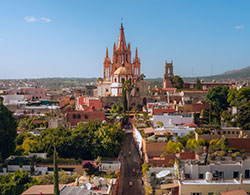
Photo by Mark Flying / Pexels |
Journey inland to discover the captivating allure of San Miguel de Allende, a colonial gem nestled in the central highlands. This city whispers tales of a bygone era through its immaculate architecture and cobblestone streets. As you wander through its enchanting plazas, adorned with colorful bougainvillea, you'll feel transported to a different time. |
| Immerse yourself in the city's rich artistic heritage by exploring museums and art galleries that showcase the talents of local artisans. San Miguel de Allende offers a serene escape where you can revel in its charming ambiance and embrace the slower pace of life.
|
Los Cabos
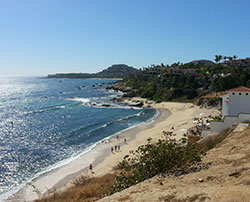
Photo by Monica_Jim0 / Pixaby | For those yearning for sun-drenched luxury, the dazzling oasis of Los Cabos awaits at the southern tip of the Baja California Peninsula. This resort town exudes elegance, boasting pristine beaches, opulent resorts, and world-class golf courses. Surrender to the soothing rhythm of the ocean as you bask in the golden rays of the sun. Indulge in pampering spa treatments, relish delectable culinary delights, and witness stunning sunsets that paint the sky with a kaleidoscope of colors. |
| Los Cabos provides an idyllic setting where you can rejuvenate your spirit and savor the pleasures of retirement.
|
Cozumel

Photo by jose Vgluis/ Adobe Stock | If you're a nature enthusiast and crave underwater adventures, the picturesque island of Cozumel is your gateway to a mesmerizing underwater world. Located off the coast of the Yucatán Peninsula, Cozumel is renowned for its crystal-clear waters and thriving marine life. Go snorkeling or scuba dive into the depths of vibrant coral reefs and delight in the variety of tropical fish. |
| As you explore this underwater paradise, you'll feel a profound sense of wonder and awe. Cozumel is a utopia for those seeking serenity, tranquility, and a profound connection with nature.
|
Lake Chapala, Jalisco
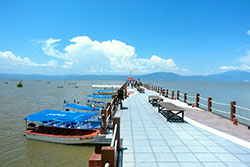
Photo by Roman Lopez / Unsplash | Lake Chapala nestled in Jalisco, Mexico is a serene haven that has become a very popular destination for retirees, many of whom relocate there. It is the largest lake in Mexico and is known for its stunning natural beauty and charming lakeside towns, such as Ajijic, which has a vibrant expat community known for its warm hospitality and lively social scene. |
| Explore Ajijic's cobblestone streets, art galleries, and colorful markets where they can discover unique crafts and local artwork. Take a leisurely boat rides on the lake and observe a rich diversity of bird species. Lake Chapala offers an array of activities and attractions, whether it's exploring the charming towns, immersing in outdoor adventures, or embracing the rich cultural tapestry, Lake Chapala presents a fulfilling and enriching experience. |
Oaxaca

Monte Albán
Photo by Gabriel Tovar/ Unsplash | Delve into the heart of Mexico's cultural tapestry by visiting the captivating state of Oaxaca. With its colonial architecture, indigenous traditions, and delectable cuisine, Oaxaca offers an immersive cultural experience. Lose yourself in the winding streets lined with colorful facades, as each step reveals a piece of history.
|
|
Explore UNESCO World Heritage Sites such as the ancient city of Monte Albán, where echoes of an ancient civilization still linger. Immerse yourself in the vibrant local markets, sampling culinary delights like mole and mezcal. Oaxaca is a true treasure trove, offering a glimpse into Mexico's captivating heritage.
|
Cancun

Photo by Ecstk22 / Adobe Stock |
Cancun is known for its pristine white-sand beaches, crystal-clear turquoise waters, and vibrant nightlife. Retirees can relax on the beach, indulge in water activities such as snorkeling or diving in the Mesoamerican Barrier Reef, the second-largest coral reef system in the world, or explore nearby attractions like the Mayan ruins of El Rey. |
|
Cancun also offers a wide range of restaurants, shopping centers, and luxury resorts, ensuring a comfortable and entertaining stay.
|
Tulum
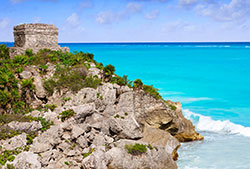
Photo by Anne Sullivan / Unsplash | Tulum, a picturesque coastal town, provides a more laid-back and bohemian atmosphere. Retirees can visit the famous Tulum Ruins, perched on a cliff overlooking the Caribbean Sea, and discover the intriguing history of the ancient Mayan civilization. ulum's pristine beaches are perfect for relaxation, and the nearby cenotes (natural sinkholes) offer refreshing swimming opportunities. |
|
Additionally, the town itself features charming boutiques, eco-friendly hotels, and wellness retreats, making it an ideal destination for relaxation and rejuvenation.
|
Best Time to Visit:
Mexico is a diverse country with a range of climates and attractions, so the best time to visit Mexico depends on the specific region and activities you have in mind. Generally, Mexico can be divided into three main climate zones: tropical, temperate, and desert.
Tropical Zone (Cancún, Riviera Maya, Cozumel, Puerto Vallarta, etc.): The tropical regions in Mexico experience a wet and dry season. The dry season, which is generally considered the best time to visit, runs from November to April. The weather is warm, sunny, and ideal for beach activities and water sports. The wet season, from May to October, brings higher temperatures, occasional rain showers, and increased humidity. However, this period can still be enjoyable for travelers, as the showers are usually brief and followed by sunny skies.
Temperate Zone (Mexico City, Oaxaca, Guadalajara, etc.): The temperate regions of Mexico have a more moderate climate with less extreme temperature variations. The weather in these areas is pleasant year-round, but the best time to visit is during the dry season, which typically lasts from November to April. The temperatures are mild, and there is less rainfall, making it ideal for exploring cities, historical sites, and engaging in outdoor activities.
Desert Zone (Baja California, Sonora, Chihuahua, etc.): The desert regions in Mexico can have extreme temperatures, particularly during the summer months. If you plan to visit these areas, it's best to go during the cooler months, from November to March, when temperatures are more comfortable for outdoor activities like hiking and exploring the unique landscapes.
It's important to note that Mexico is a popular tourist destination, and certain regions may be crowded during peak seasons, such as winter holidays and spring break. Additionally, specific events and festivals may influence your decision to visit. It's always a good idea to check the local weather and consider any local festivities or holidays when planning your trip to Mexico.
Travel Planning Tips:
Plan Ahead: Research and plan your itinerary in advance to make the most of your time in Mexico. Consider the locations you want to visit, the duration of your stay, and any specific attractions or activities you don't want to miss.
Cash and Currency: The official currency of Mexico is the Mexican Peso (MXN). It's advisable to carry some local currency for small expenses, as not all establishments accept credit cards. You can exchange currency at banks, exchange offices (casas de cambio), or withdraw Mexican Pesos from ATMs.
Travel Insurance: Ensure that you have comprehensive travel insurance that covers medical expenses, trip cancellation, trip cancellation, lost luggage, and any potential emergencies. Make sure to review your insurance policy to understand what is covered and consider purchasing comprehensive coverage. Review the policy details and know how to access medical assistance if needed.
Language, Local Customs and Etiquette: The official language of Mexico is Spanish. While many people working in the tourism industry may speak English, learning a few basic Spanish phrases can be helpful for communication with locals and enhance your overall experience. Familiarize yourself with local customs and etiquette to show respect to the Mexican culture. Learn about basic cultural norms, such as appropriate dress codes for religious sites and local traditions.
Sun Protection:Much of Mexico enjoys a sunny climate, so it's essential to protect yourself from the sun. Wear sunscreen, a hat, and sunglasses, and seek shade during the hottest hours of the day to prevent sunburn and dehydration.
Travel Documents: Ensure you have a valid passport with at least six months' validity remaining. Check if you require a visa to enter Spain, depending on your nationality, and ensure you have all the necessary travel documents.
Remember to check the latest travel advisories and guidelines from your country's government before your trip to Greece, as situations and requirements may change.
Accommodations:
Mexico offers a wide range of accommodation options, including hotels, hostels, vacation rentals, and rural guesthouses. Book in advance, especially during peak seasons, to secure the best deals and availability.
All-Inclusive Resorts: Many retirees appreciate the convenience and amenities offered by all-inclusive resorts. These resorts typically provide comfortable accommodations, meals, drinks, entertainment, and various activities on-site. They often have features like pools, spas, fitness centers, and organized events, allowing retirees to relax and enjoy their vacation without worrying about logistics.
Boutique Hotels: Boutique hotels are smaller, intimate properties that offer a more personalized and unique experience. They often have distinctive architecture, stylish decor, and personalized services. Retirees may enjoy the attention to detail, personalized service, and tranquil ambiance provided by boutique hotels.
Condo Rentals: Renting a condo or an apartment is a popular option for retirees who prefer a home-like setting with more space and privacy. Condo rentals often come equipped with a kitchen, living area, and amenities such as pools, gyms, and access to communal facilities. This type of accommodation allows retirees to have the freedom to cook their meals and enjoy a more independent lifestyle during their vacation.
Retirement Communities: Mexico is home to various retirement communities that cater specifically to retirees. These communities provide long-term stays and often offer amenities such as golf courses, wellness centers, social activities, and access to healthcare services. Retirees may find comfort in a community of like-minded individuals and enjoy the convenience of comprehensive amenities.
Wellness Retreats: Mexico is known for its wellness retreats that focus on rejuvenation, relaxation, and overall well-being. These retreats often offer programs such as yoga, meditation, spa treatments, healthy cuisine, and wellness activities. Retirees looking for a tranquil and health-focused vacation may find these retreats appealing.
Long-Term Rentals: Retirees planning an extended stay in Mexico may opt for long-term rentals, such as furnished apartments or houses. This option provides a more affordable and flexible choice, allowing retirees to immerse themselves in local communities, experience the culture, and enjoy a longer vacation without the constraints of a hotel stay.
Transportation:
Mexico offers a diverse array of transportation options that are both safe and widely accessible across most regions of the country. From well-maintained highways to reliable public transportation systems, such as buses and metros in major cities, to the ubiquity of taxis and rideshare services, Mexico provides a range of travel choices catering to various preferences and budgets. Additionally, intercity buses operated by reputable companies offer comfortable and secure journeys, making transportation in Mexico both convenient and dependable.
- Domestic Flights: Mexico has a well-developed domestic flight network, making it convenient to travel between major cities and popular tourist destinations. Airlines such as Aeroméxico, Volaris, Interjet, and VivaAerobus operate domestic flights, offering a faster way to cover long distances.
- Trains: While train travel is not as extensive in Mexico as in some other countries, there are a few scenic train routes available. The most notable is the Chihuahua-Pacific Railway (Chepe), which runs through the Copper Canyon region, offering stunning views. Other tourist-oriented train services, such as the Tequila Express, provide unique experiences in specific regions.
- Buses: Buses are a popular and affordable mode of transportation in Mexico, offering extensive coverage throughout the country. Long-distance buses, known as "autobuses" or "camiones," are operated by companies like ADO, ETN, and Primera Plus. They provide comfortable seating, air conditioning, and onboard amenities, making them a convenient option for traveling between cities and towns.
- Rental Cars: Renting a car gives you the flexibility to explore at your own pace, especially if you plan to visit more remote areas or off-the-beaten-path destinations. Major international car rental companies, as well as local providers, operate in Mexico. However, driving conditions and traffic regulations may vary, so it's recommended to familiarize yourself with local driving laws and consider insurance coverage.
- Taxis: Taxis are widely available in Mexico, especially in urban areas and tourist destinations. In cities, you'll find both traditional taxis and ride-hailing services like Uber, DiDi, and Cabify. It's advisable to use official taxis or reputable ride-hailing apps for safety and fare transparency. In smaller towns, taxis may not have meters, so it's important to agree on the fare before starting the ride.
- Ferries: Mexico's coastal regions offer ferry services to nearby islands or across bodies of water. For example, ferries operate between the mainland and destinations like Cozumel, Isla Mujeres, and Baja California. These ferry services provide an alternative means of transportation, especially for island hopping or exploring coastal areas.
- Public Transportation:
Public transportation systems, such as buses and metro systems, are available in major cities like Mexico City, Guadalajara, and Monterrey. These options are often affordable and can be convenient for getting around within the city. However, it's important to be aware of your belongings and be cautious of crowded spaces, especially during peak hours.
Safety Tips:
- Safety Precautions:
Mexico is generally safe, it's important to stay informed about safety risks and avoid areas known for crime or violence. Prioritize your well-being and enjoy peace of mind during your travels. Lastly, ensure you have the necessary documentation, including a valid passport and visa if required, to smoothly enter Mexico. Do not overstay your visa. For up-to-date information, consult the official Mexican government website.
- Be Mindful of your Belongings: Keep your valuables, including passports, travel documents, and money, in a secure place such as a hotel safe. When you're out and about, be aware of your surroundings and avoid displaying expensive items that may attract unwanted attention. Use a concealed money belt or a secure bag to carry your belongings.
- Stay in Popular and Well-Lit Areas: Stick to well-populated and well-lit areas, especially at night. Avoid wandering into unfamiliar or poorly lit areas that may pose a higher risk. If you're unsure about the safety of a particular neighborhood or area, seek advice from local authorities or your hotel.
- Stay Vigilant with Your Personal Security: Trust your instincts and be aware of your personal security at all times. Avoid excessive alcohol consumption or drug use, as it can impair judgment and make you more vulnerable. Travel in groups whenever possible, especially at night, and inform someone trustworthy about your itinerary and plans.
- Vaccinations: Check with your healthcare provider or travel clinic about recommended vaccinations before visiting Mexico.
- Medical Facilities: Familiarize yourself with the location of medical facilities, clinics, and hospitals near your travel destinations. Keep a list of emergency contact numbers and addresses readily available.
- Prescription Medications:If you take prescription medications, ensure you have an ample supply for the duration of your trip. Carry them in their original packaging, along with copies of prescriptions, in case you need to refill or replace them while traveling.
- Hygiene and Food Safety: : Check if any vaccinations are recommended for Mexico and ensure you have necessary medications. Drink bottled or purified water and be cautious with street food, choosing reputable establishments. Use hand sanitizers and practice good hygiene to avoid any potential health issues.
- Stay Hydrated: Maintain adequate hydration by drinking plenty of water, especially in warmer months or when participating in outdoor activities. Carry a refillable water bottle and stay hydrated throughout the day.
- Emergency Numbers: Familiarize yourself with the emergency contact numbers in Mexico including the general emergency number (911), local police, and medical services.
- Respect Local Customs and Laws: Familiarize yourself with local laws and customs to avoid any unintentional violations that could lead to problems. Show respect for local culture, traditions, and customs. Follow dress codes, especially in religious sites, and be mindful of local sensitivities.
- Travel Advisories: Stay updated on current events, local regulations, and any travel advisories when traveling in Mexico. Visit the US Government State Department Travel Advisories web site to check on the status of your destination.
- Enroll in the STEP Program: Travelers are also urged to enroll in the U.S. State Department's Smart Traveler Enrollment Program (STEP) to receive security messages and to make it easier to locate them in an emergency. The Department uses these security messages to convey information about terrorist threats, security incidents, planned demonstrations, natural disasters, etc. In an emergency, please contact the nearest U.S. Embassy or consulate or call the following numbers: 1 (888) 407-4747 (toll-free in the United States and Canada) or 1 (202) 501-4444 from other countries.
| |
 Chichen Itza, Mexico Photo by
Filip Gielda / Unsplash
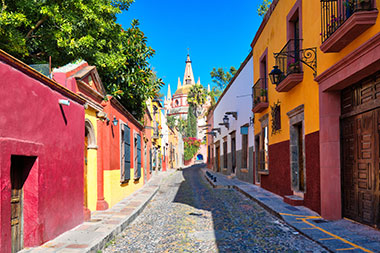 San Miguel de Allende Photo by Eskystudio / Adobe Stock
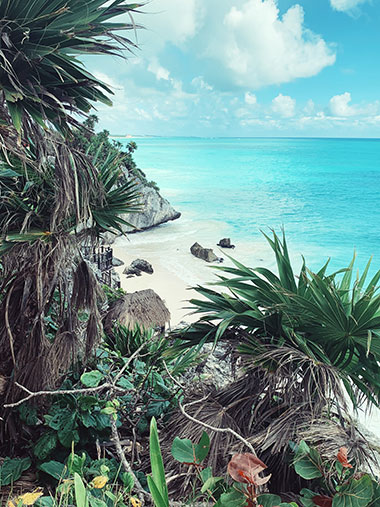 Tulum coast Photo by Anna Sullivan / Unsplash
|
 Chichen Itza, Mexico
Chichen Itza, Mexico San Miguel de Allende
San Miguel de Allende Tulum coast
Tulum coast